Practice Test 1 - AP Biology Premium 2024
Section I: Multiple-Choice
TIME: 90 MINUTES

1. The following figure shows the interaction of water molecules with sodium chloride.
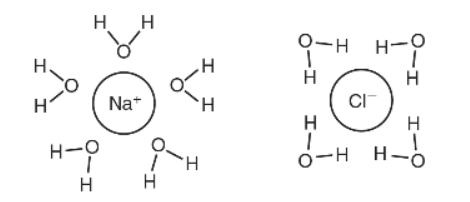
Which of the following statements best explains the arrangement of the molecules in this figure?
(A) Water is nonpolar, and it can easily dissolve ionic compounds by surrounding both negative ions and positive ions with a nonpolar ring of water molecules.
(B) Water is polar, and it can easily dissolve ionic compounds by surrounding negative ions with partially positive hydrogen atoms and by surrounding positive ions with partially negative oxygen atoms.
(C) Water and sodium chloride are both nonpolar molecules, and this allows sodium chloride to dissolve in water.
(D) Hydrogen bonds form between water molecules and the ions in sodium chloride.
2. The following figure shows the interaction between water molecules and a micelle (a spherical formation of lipids dissolved in an aqueous environment).
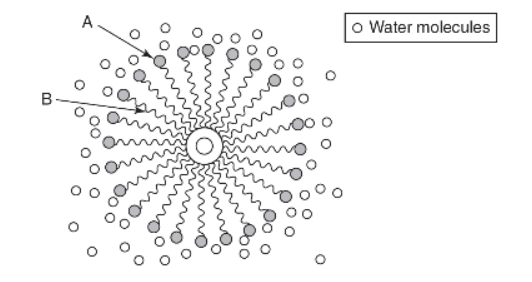
Which of the following correctly describes the parts of the micelle labeled A and B?
(A) Part A represents the hydrophilic phosphate head of a phospholipid, and part B represents the hydrophobic lipid tail of a phospholipid.
(B) Part A represents the hydrophobic phosphate head of a phospholipid, and part B represents the hydrophilic lipid tail of a phospholipid.
(C) Part A represents the glycosidic head of a glycosphingolipid, and part B represents the hydrophilic tail of a phospholipid.
(D) Part A represents the inorganic phosphate compound, and part B represents the fatty sterol cholesterol.
Questions 3–5
A student conducts an experiment to find out how many drops of different liquids can be placed on the surface of a penny before the liquids flow over the sides of the penny. Data are shown in the following table.
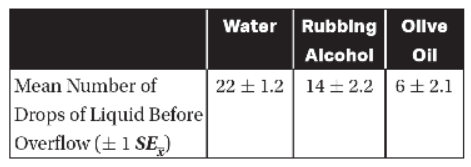
3. Which of the following graphs most accurately represents the data, including 95% confidence intervals?
(A)
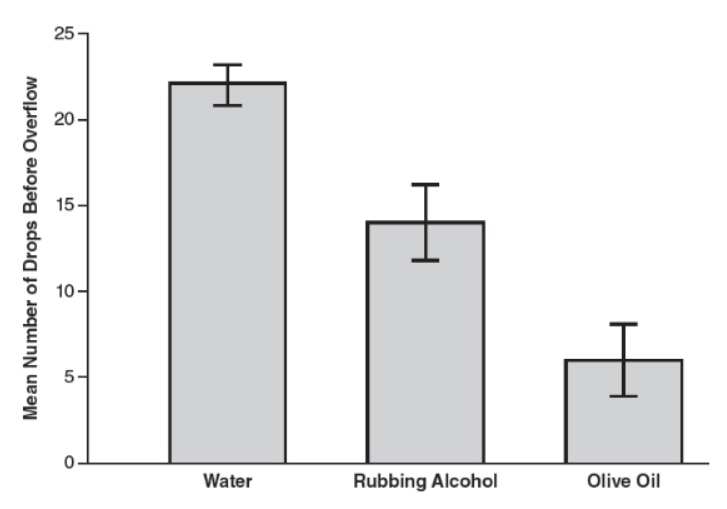
(B)
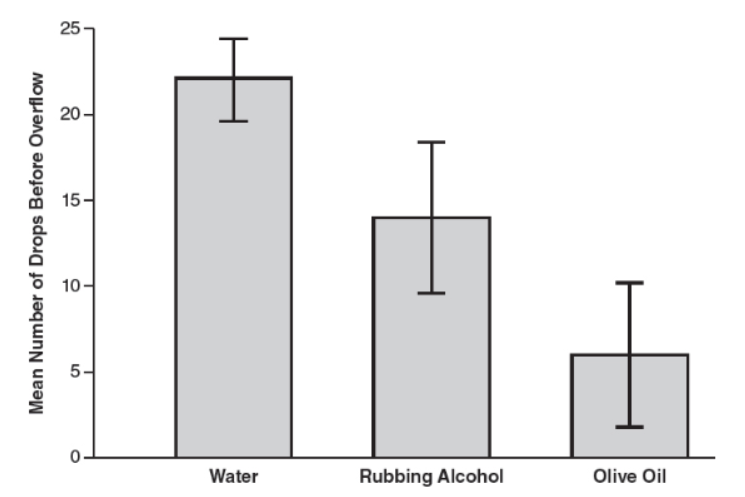
(C)
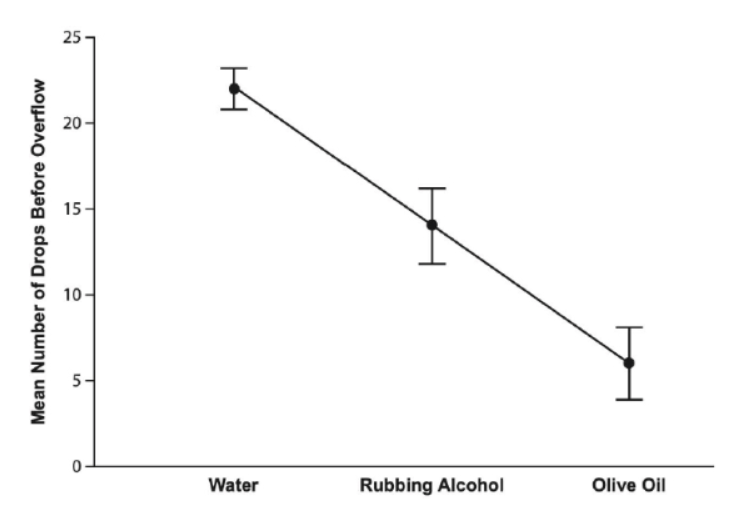
(D)
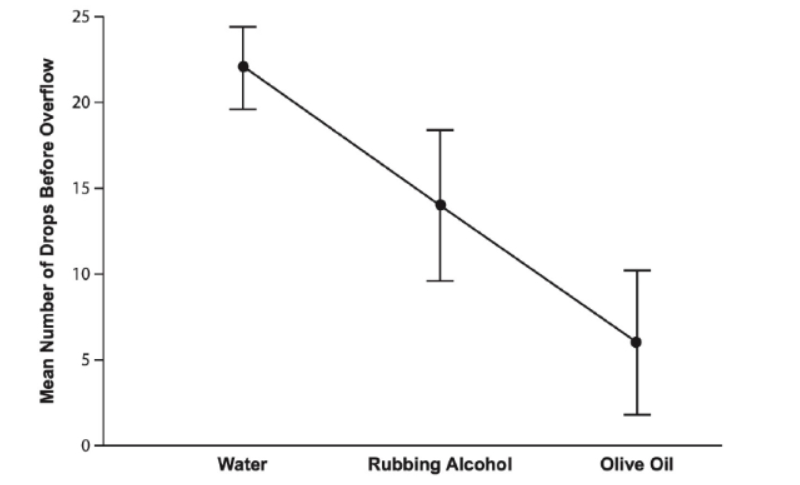
4. Which two liquids are least likely to have a statistically significant difference between their means?
(A) water and rubbing alcohol (because their 95% confidence intervals do overlap)
(B) water and olive oil (because their 95% confidence intervals do not overlap)
(C) water and rubbing alcohol (because their 95% confidence intervals do not overlap)
(D) rubbing alcohol and olive oil (because their 95% confidence intervals do overlap)
5. The student repeats the experiment, but before doing so, first coats the surface of the penny with a thin layer of surfactant (a chemical compound that disrupts the formation of hydrogen bonds). Predict the effect the surfactant will have on the number of drops of water that can be placed on the surface of the penny before overflow occurs, and justify your prediction.
(A) The number of drops of water will decrease due to fewer hydrogen bonds forming between the water molecules.
(B) The number of drops of water will decrease due to fewer polar ends forming within the water molecules.
(C) The number of drops of water will increase due to increased polar covalent bonds within the water molecules.
(D) The number of drops of water will increase due to increased surface tension.
6. Which of the following biological molecules is the carrier of genetic information?
(A) carbohydrates
(B) lipids
(C) nucleic acids
(D) proteins
7. Which of the following correctly describes what would be needed to break down a polypeptide chain into its 15 component amino acids?
(A) dehydration reactions that would produce 15 water molecules
(B) dehydration reactions that would consume 14 water molecules
(C) hydrolysis reactions that would produce 15 water molecules
(D) hydrolysis reactions that would consume 14 water molecules
8. Which of the following is a correct statement about protein structure?
(A) Primary structure is formed by hydrophobic interactions.
(B) Secondary structure is formed by hydrogen bonds.
(C) Tertiary structure is formed by peptide bonds.
(D) Quaternary structures are found in all proteins.
Questions 9–11
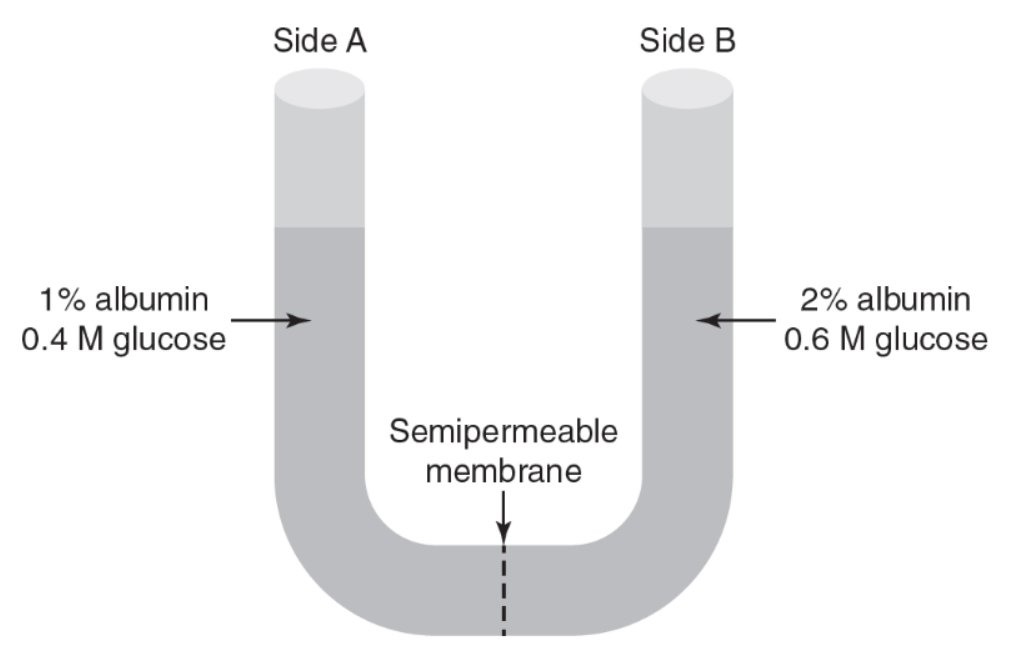
The two sides of the U-tube apparatus are separated by a semipermeable membrane. The aqueous solution on side A of the U-tube contains 1% albumin and 0.4 M glucose. The aqueous solution on side B contains 2% albumin and 0.6 M glucose.
9. Which of the following statements is correct?
(A) Side A initially has a higher water potential than side B because side A has a lower solute concentration than side B.
(B) Side B initially has a higher water potential than side A because side B has a higher solute concentration than side A.
(C) Side A and side B initially have the same water potential because they are both aqueous solutions.
(D) Side A and side B initially have the same water potential because they both contain the same types of solutes.
10. Glucose may pass through the semipermeable membrane in the U-tube, but albumin may not. If the solutions on each side of the U-tube apparatus are allowed to equilibrate for 30 minutes, which of the following is the most likely result?
(A) The concentration of glucose on side B will increase.
(B) The concentration of albumin on side A will increase.
(C) The concentration of glucose on side A will increase.
(D) The concentration of albumin on side B will increase.
11. Which of the following correctly predicts and explains the movement of water in the U-tube after 30 minutes?
(A) Water will move from side A to side B because the water potential on side A will be higher than the water potential on side B.
(B) Water will move from side A to side B because the water potential on side B will be higher than the water potential on side A.
(C) Water will move from side B to side A because the water potential on side A will be higher than the water potential on side B.
(D) Water will move from side B to side A because the water potential on side B will be higher than the water potential on side A.
Questions 12–14
Refer to the following table.
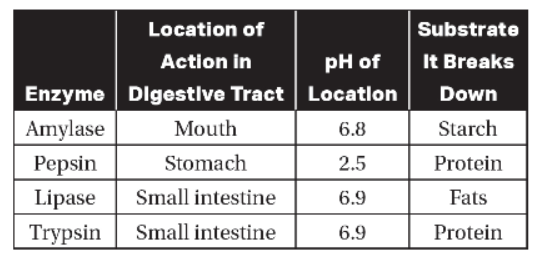
12. Which of the following graphs most likely reflects the activity of pepsin at different pHs?
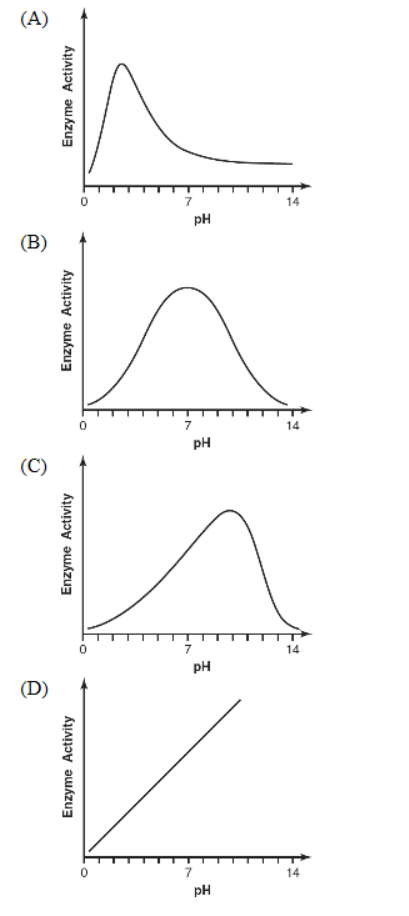
13. A person eats enough antacids to raise the pH of both his mouth and his stomach acid. The activities of which enzymes would most likely be affected by this?
(A) amylase and pepsin
(B) pepsin and lipase
(C) lipase and trypsin
(D) trypsin and amylase
14. The pyloric sphincter controls the flow of the contents of the stomach (chyme) into the small intestine. The pyloric sphincter prevents the acidic chyme from the stomach from entering the small intestine until the pancreas is ready to secrete bicarbonate into the small intestine, which neutralizes the acids in the chyme. If the pyloric sphincter was damaged and could not control the flow of chyme into the small intestine, which enzymes would most likely have reduced activity during digestion?
(A) amylase and pepsin
(B) pepsin and lipase
(C) lipase and trypsin
(D) trypsin and amylase
15. Which of the following processes occurs in anaerobic prokaryotes?
(A) glycolysis
(B) Krebs cycle
(C) oxidation of pyruvate
(D) oxidative phosphorylation
Questions 16–18
In a classic experiment to determine which wavelengths of light produce the greatest amounts of photosynthesis in photosynthetic algae, light was passed through a prism to shine different colors of light onto the photosynthetic algae Spirogyra (that was placed on a microscope slide), as shown in the following figure.
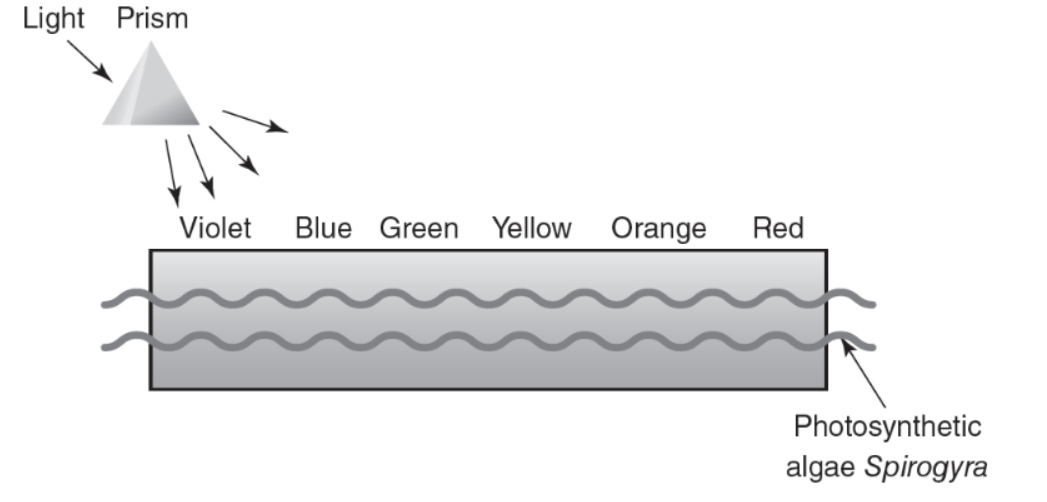
Aerobic bacteria (that need oxygen to survive) were layered on top of the algae. The wavelengths (in nm) of different colors of visible light are noted in the table.
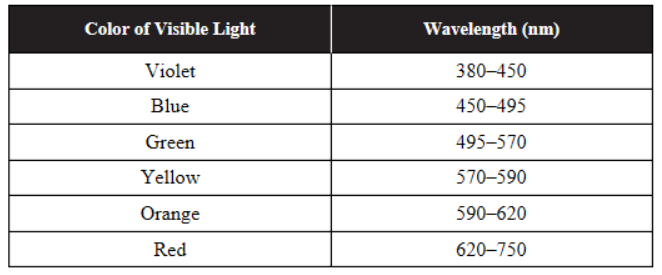
16. The greatest numbers of aerobic bacteria were found on the slide where the wavelength of light was between 420–470 nm and 660–700 nm. What conclusion could be drawn from this data?
(A) Algae produce the same amount of oxygen when exposed to any color of light.
(B) Algae produce oxygen only when in the presence of aerobic bacteria.
(C) Algae produce the most oxygen when exposed to green light.
(D) Algae produce the most oxygen when exposed to blue-violet or red light.
17. Further research revealed that the light-absorbing pigment in the algae Spirogyra (that was used in this experiment) was chlorophyll, which absorbs the most light energy in the wavelength ranges of 420–470 nm and 660–700 nm. Some photosynthetic red algae use the pigment phycoerythrin, which absorbs the most light energy in the wavelength range of 495–570 nm. If this experiment was repeated with photosynthetic red algae, near which color of light on the slide would you expect to see the greatest number of bacteria?
(A) violet
(B) green
(C) orange
(D) red
18. What is the role of light energy in photosynthesis?
(A) to activate the expression of genes needed for photosynthesis
(B) to trigger a cell signaling pathway that produces carbon dioxide
(C) to excite the electrons in the photosystems
(D) to fix carbon dioxide during the Krebs (citric acid) cycle
Questions 19 and 20
Equal numbers of germinating mung beans were placed in sealed chambers of equal volumes with probes that measured the levels of oxygen and carbon dioxide gas over time. One chamber was kept at a temperature of 4° Celsius, and the other chamber was kept at a temperature of 25° Celsius for the duration of the experiment.
19. What is the independent variable in this experiment?
(A) the number of germinating mung beans
(B) the temperature of the chambers
(C) the amount of carbon dioxide produced
(D) the amount of oxygen consumed
20. This graph shows the carbon dioxide levels in both chambers during a 30-minute period.
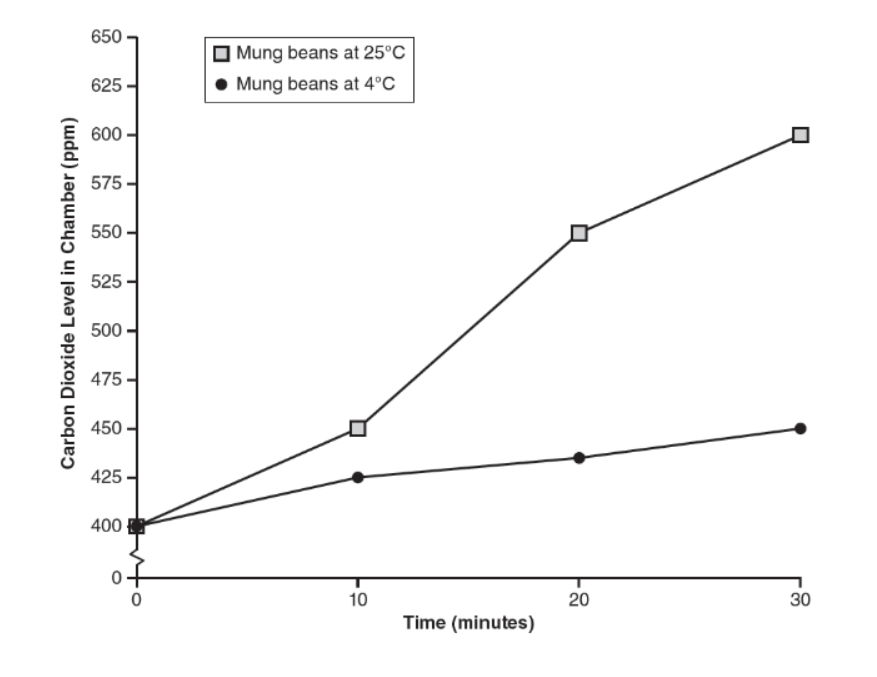
Which of the following correctly states the results of this experiment?
(A) The mung beans at 4° Celsius increased the level of carbon dioxide in the chamber at a rate of 6.67 ppm CO2 per minute and had a higher respiration rate than the mung beans at 25° Celsius.
(B) The mung beans at 4° Celsius increased the level of carbon dioxide in the chamber at a rate of 1.67 ppm CO2 per minute and had a higher respiration rate than the mung beans at 25° Celsius.
(C) The mung beans at 25° Celsius increased the level of carbon dioxide in the chamber at a rate of 6.67 ppm CO2 per minute and had a higher respiration rate than the mung beans at 4° Celsius.
(D) The mung beans at 25° Celsius increased the level of carbon dioxide in the chamber at a rate of 1.67 ppm CO2 per minute and had a higher respiration rate than the mung beans at 4° Celsius.
21. A cell secretes a growth factor that slowly diffuses to nearby cells, stimulating the growth of those cells. This is an example of __________ signaling.
(A) autocrine
(B) juxtacrine
(C) paracrine
(D) endocrine
22. Quorum sensing is used by bacteria to sense the density of bacteria in the area. Bacteria release a signaling molecule that travels short distances to receptors on nearby bacteria. This would best be described as which type of cell signaling?
(A) synaptic
(B) cytokine
(C) paracrine
(D) endocrine
23. Estradiol and testosterone are steroid hormones. Which type of receptor are they most likely to bind to?
(A) a G-protein-linked receptor
(B) a tyrosine kinase receptor
(C) an intracellular cytoplasmic receptor
(D) a membrane ion channel receptor
24. cAMP and Ca2+ ions are examples of ___________.
(A) cell membrane receptors
(B) ligands
(C) intracellular cytoplasmic receptors
(D) secondary messengers
25. Gap junctions in animal cells and plasmodesmata in plant cells are examples of which type of signaling?
(A) autocrine
(B) juxtacrine
(C) paracrine
(D) endocrine
26. How does a cell that has just completed the S stage of the cell cycle compare to the same cell at the start of the S stage?
(A) It has twice the amount of DNA and twice the number of chromosomes.
(B) It has twice the amount of DNA and the same number of chromosomes.
(C) It has the same amount of DNA and twice the number of chromosomes.
(D) It has the same amount of DNA and the same number of chromosomes.
27. During which stage of the cell cycle are you most likely to find cells that have fully differentiated and are not actively dividing?
(A) G0
(B) G1
(C) S
(D) G2
28. ___________ are present at near-constant levels during the cell cycle and are dependent on rising levels of ___________ to become active.
(A) Cyclins; mitosis-promoting factor
(B) Cyclins; cyclin-dependent kinases
(C) Cyclin-dependent kinases; cyclins
(D) Cyclin-dependent kinases; phosphatases
29. The three major events of the division of the genetic material during cell replication are (1) replication of the genetic material, (2) alignment of chromosomes, and (3) separation of chromosomes. These events happen during which stages (respectively)?
(A) S, G1, G2
(B) S, metaphase, anaphase
(C) G2, metaphase, telophase
(D) prophase, metaphase, anaphase
30. Which of the following would affect the greatest number of steps in the signal transduction process?
(A) an antibody irreversibly binding to a cell membrane receptor
(B) deletion of the gene for the enzyme adenylyl cyclase
(C) inactivation of a cytoplasmic protein kinase
(D) introduction of an inhibitor of a protein phosphatase
Questions 31 and 32
The ability to taste phenylthiocarbamide (PTC) is a dominant trait. Nontasters of PTC are recessive. In a population that is not in Hardy-Weinberg equilibrium, there are 520 homozygous dominant tasters, 400 heterozygous tasters, and 80 nontasters of PTC.
31. What is the frequency of the nontaster allele?
(A) 0.28
(B) 0.44
(C) 0.56
(D) 0.72
32. What is the frequency of individuals who are carriers of the nontasting allele?
(A) 0.08
(B) 0.40
(C) 0.50
(D) 0.52
Questions 33 and 34
Refer to the following table.
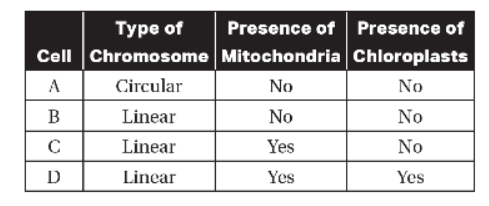
33. Which of the cells in this table shares characteristics of both prokaryotic and eukaryotic cells?
(A) A
(B) B
(C) C
(D) D
34. Which of the organisms in the table is most closely related to modern plants?
(A) A
(B) B
(C) C
(D) D
35. Two species of deer live on different mountain ranges separated by 500 miles. Which type of reproductive isolation does this scenario represent?
(A) habitat isolation
(B) temporal isolation
(C) behavioral isolation
(D) mechanical isolation
36. Sea urchins release their sperm and eggs into the water. However, the sperm from red sea urchins cannot fertilize the eggs from purple sea urchins. Which type of reproductive isolation is this?
(A) mechanical isolation
(B) gametic isolation
(C) reduced hybrid fertility
(D) hybrid breakdown
37. A template strand of DNA has the following sequence:

What is the complementary strand created during DNA replication?
(A) 3′-TTA AGG CCT AGC-5′
(B) 5′-TTA AGG CCT AGC-3′
(C) 3′-UUA AGG CCU AGC-5′
(D) 5′-UUA AGG CCU AGC-3′
38. Which of the following statements best explains the mechanism for DNA replication?
(A) DNA replication is reductive, because half of the total DNA present is copied.
(B) DNA replication is semiconservative, because each DNA strand serves as a template for a new strand during replication.
(C) DNA replication is dispersive, because the two resulting DNA molecules are random mixtures of parent and daughter DNA.
(D) DNA replication is conservative, because one resulting molecule is identical to the original and the other consists of two new strands.
39. In DNA replication, DNA “unwinds” to form two template strands: the leading strand and the lagging strand. Which of the following statements about these strands is true?
(A) On the lagging strand, short fragments are formed when the new strand of DNA is synthesized.
(B) The leading strand of DNA is synthesized discontinuously.
(C) DNA polymerase can only synthesize DNA on the leading strand.
(D) The lagging strand can only be synthesized once the leading strand has been completed.
40. Which of the following is the enzyme used during transcription that directly generates the transcript?
(A) helicase
(B) ligase
(C) DNA polymerase
(D) RNA polymerase
41. Which of the following statements about introns is true?
(A) Introns are translated by ribosomes.
(B) Introns have no function in the chromosomes.
(C) Introns are found in eukaryotes.
(D) Introns are found only in prokaryotes.
42. Streptomycin, a commonly used antibiotic, interferes with bacterial ribosomes. Which process would most likely be negatively affected by streptomycin?
(A) DNA replication
(B) posttranscriptional modification of mRNA
(C) transcription
(D) translation
43. A scientist is studying a eukaryotic gene that is 15,000 base pairs long. The scientist isolates the mRNA (produced by this gene) from the cytosol and finds that it is only 12,000 base pairs long. Why is the isolated mRNA not the same length as the DNA that codes for it?
(A) The scientist made a mistake and isolated the wrong mRNA.
(B) Introns are removed from eukaryotic mRNAs, so the mRNA is shorter than the DNA.
(C) RNA is less stable than DNA and is more likely to degrade in the cell.
(D) The poly-A tail on the mRNA results in an mRNA that is shorter than the gene.
44. In the cross AABbCc × AaBbCC, what is the probability of producing an offspring with the genotype AaBbCc?
(A) 0
(B) 1/8
(C) 1/4
(D) 1/2
45. Based on this pedigree, what is the most likely mode of inheritance of the trait?
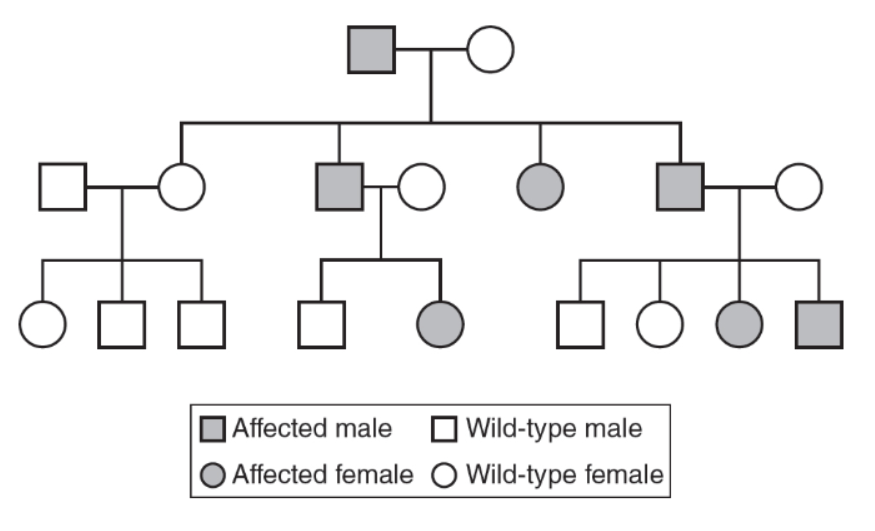
(A) autosomal dominant
(B) sex-linked dominant
(C) sex-linked recessive
(D) mitochondrial inheritance
Questions 46–48
Color blindness in humans is a sex-linked recessive trait. A female who is not color blind, but whose father was color blind, has children with a male who is not color blind.
46. What is the likelihood that their son will be color blind?
(A) 0%
(B) 25%
(C) 50%
(D) 100%
47. What is the likelihood that their daughter will be color blind?
(A) 0%
(B) 25%
(C) 50%
(D) 100%
48. Which of the following is a likely pedigree for this family? Note that circles indicate females, and squares indicate males. Shaded circles and squares indicate individuals with the trait.
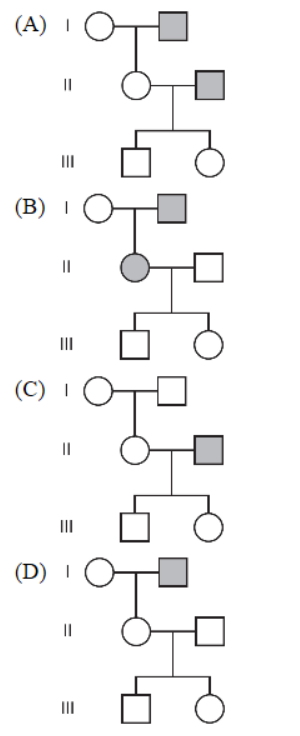
49. Which of the following is a density-independent factor that can limit population size?
(A) competition
(B) disease
(C) predation
(D) weather
Questions 50 and 51
Refer to the following graph.
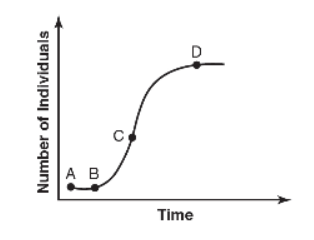
50. Which point on the graph represents the carrying capacity of the environment for this population?
(A) A
(B) B
(C) C
(D) D
51. Which point on the diagram most likely represents a point in which the population is growing exponentially?
(A) A
(B) B
(C) C
(D) D
52. Sea anemones, which live as sessile forms attached to rock surfaces, have stinging nematocysts that release paralyzing toxins (upon contact) into their prey, such as fish. Tentacles move the paralyzed prey into the gastric cavity for ingestion.
Clown fish are covered with a thin layer of mucus that prevents them from being paralyzed by sea anemone toxins. Clown fish live among the tentacles, which provide protection. Predators that attempt to eat clown fish are stung by the sea anemone nematocysts and are then consumed by the sea anemone.
Which of the following correctly describes the relationship between sea anemones and clown fish?
(A) commensalism
(B) competition
(C) mutualism
(D) parasitism
53. In the marine ecosystems on the Pacific Coast of Washington state, sea otters eat sea urchins. Sea urchins eat kelp. Kelp forests provide food and habitat for a wide variety of marine organisms. Due to overhunting from 1750 to 1910, sea otter populations were reduced from over 100,000 to less than 2,000. By 1910, kelp forests off the coast of Washington state virtually disappeared, and the biodiversity of the marine ecosystems on the coast was greatly reduced. Which of the following best describes the ecological role of the sea otter in this ecosystem?
(A) autotroph
(B) detritivore
(C) keystone species
(D) prey species
54. Which of the following is a correct statement about energy in ecosystems?
(A) A net gain in energy can result in the loss of mass and the death of the organism.
(B) Energy is recycled through ecosystems.
(C) Changes in energy availability can disrupt ecosystems.
(D) Heterotrophs capture the energy in sunlight.
55. Which of the following statements about population growth is false?
(A) Reproduction without limiting factors results in the exponential growth of a population.
(B) Density-dependent limits to populations results in logistic growth of a population.
(C) The carrying capacity of an environment depends on resource availability.
(D) K-selected populations can far exceed their environment’s carrying capacity.
56. The synthesis of the amino acid tryptophan in bacteria is controlled by the repressible trp operon. The following figure represents components of the trp operon.
.png)
Which of the following best represents the trp operon when the amino acid tryptophan is present in the bacteria’s environment?




57. The digestion of the sugar lactose in bacteria is controlled by the inducible lac operon. This figure represents the components of the lac operon.

Which of the following best represents the lac operon when the sugar lactose is present in the bacteria’s environment?
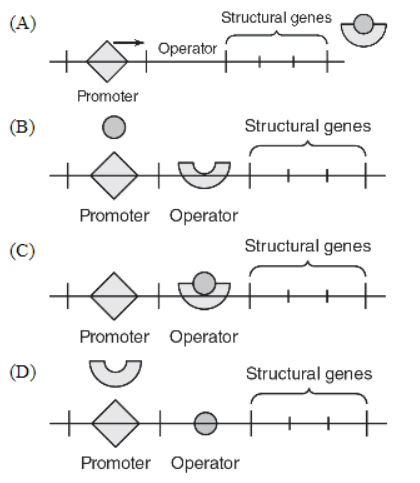
58. Transmembrane proteins span across the entire cell membrane. Where would the hydrophobic amino acids in a transmembrane protein most likely be found?
(A) in contact with the polar phosphates of the phospholipids
(B) on the outer surface of the membrane in contact with the cell’s aqueous surroundings
(C) in contact with the nonpolar fatty acid chains of the phospholipids
(D) on the inner surface of the membrane in contact with the cell’s cytosol
59. In the alpha cells in the pancreas, which produce the peptide hormone insulin, there would likely be a high concentration of which of the following?
(A) lysosomes
(B) centrioles
(C) smooth endoplasmic reticulum
(D) ribosomes
60. A geneticist discovers a previously unknown genetic disorder. Pedigree analysis shows that both males and females can inherit this disorder from their mother but not from their father. Affected females can pass on the allele for this disorder to the next generation, but affected males will not pass on this disorder to the next generation. What is the most likely mode of inheritance of this disorder?
(A) sex-linked recessive
(B) mitochondrial inheritance
(C) autosomal recessive
(D) autosomal dominant

Section II: Free-Response
TIME: 90 MINUTES

1. A scientist completes an analysis of the amino acid sequences of cytochrome c in six different species. The scientist compares how many amino acid differences there are between the cytochrome c protein in humans and that of each of the six different species in the table. The number of amino acid differences is shown in the table.
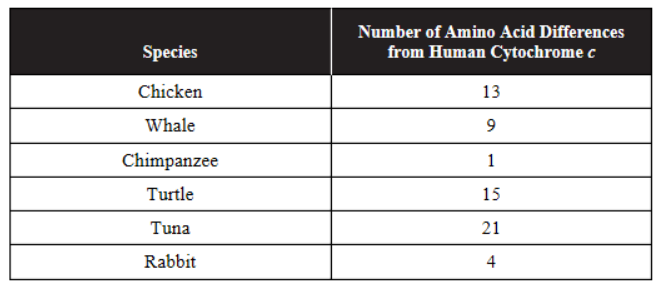
(a) Explain how amino acid differences in a conserved protein can help scientists determine degrees of relationships between organisms.
(b) Analyze the data, and use it to construct a cladogram of these organisms using the template provided.
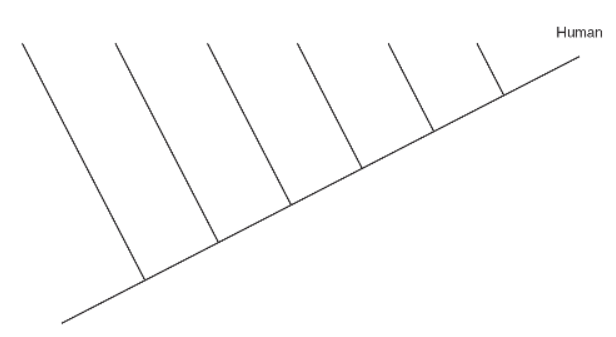
(c) Justify your placement of the organisms on the cladogram in your response to part (b).
(d) A claim is made that chickens share a more recent common ancestor with humans than turtles do. Identify at least one piece of experimental evidence that might be used to support this claim.
2. A botanist measures the stomatal density on both the upper surface (facing the sun) and lower surface (shaded from the sun) of the leaves from two plant species. Purple passionflower, Passiflora incarnata, is native to Florida and Texas and is found in habitats with a humid climate. White oak, Quercus alba, is native to the central and northern United States and prefers a drier climate with seasons. The mean stomatal density and the standard errors of the mean are shown in the following table.

(a) Describe the role of stomata in water regulation and photosynthesis in plants.
(b) Construct a graph that shows the mean stomatal density for both the upper and lower leaf surfaces of both plants. Be sure to include 95% confidence intervals.

(c) Analyze the data to determine whether there is a statistically significant difference in the mean stomatal densities between the two plants.
(d) Make a claim explaining why the mean stomatal density on the upper surface of the leaves of Passiflora incarnata is different than the mean stomatal density on the upper surface of the leaves of Quercus alba. Justify your claim with your knowledge of the role stomata play in water regulation and photosynthesis in plants.
3. A student conducts an investigation to measure the amount of gas produced by the aquatic plant Elodea. Equal amounts of Elodea are placed in inverted test tubes in four different water baths (at different temperatures) under lights (of the same intensity), as shown in the figure.
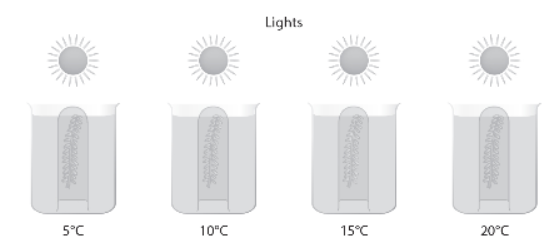
The size of the gas bubble at the top of the inverted test tube is measured after 30 minutes, and that data are displayed in the following table.

(a) Describe why a gas bubble would form in each tube.
(b) Identify the independent variable, the dependent variable, and at least one experimental control.
(c) Predict the size of the gas bubble if the experiment was repeated with a water bath at a temperature of 25°C.
(d) Justify your prediction from part (c).
4. Acetylcholine (ACh) is a neurotransmitter. The binding of acetylcholine to membrane receptors starts a cell signaling cascade in neurons.
(a) Describe the three steps in cell signaling.
(b) Explain how cell signals are amplified in the cell.
(c) An autoimmune disorder produces antibodies that bind to the acetylcholine receptors, blocking them. Predict the effect this would have on the cell signaling pathway that involves acetylcholine.
(d) Justify your prediction from part (c).
5. A student performs a bacterial transformation experiment. Wild-type E. coli are transformed with a plasmid containing the green fluorescent protein (GFP) gene. The GFP gene is attached to the control elements of the repressible tryptophan operon. A diagram of the plasmid is shown in the figure.
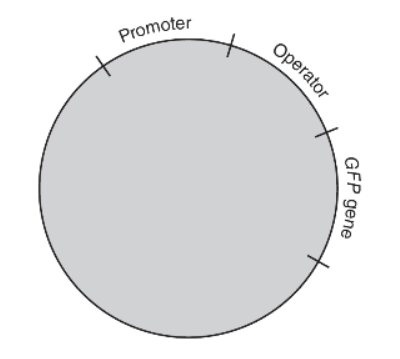
(a) Describe the roles of the promoter and operator in operons.
(b) Explain the effect, if any, of adding tryptophan to the medium in which the transformed bacteria are growing.
(c) Tryptophan is added to the medium in which the bacteria are growing. Using an “X” for tryptophan and an “O” for the repressor protein, represent the likely locations of tryptophan and the repressor protein on or around the operon in the figure above.
(d) Explain how the regulation of the expression of the tryptophan operon relates to negative feedback.
6. In pea plants, round peas are dominant over wrinkled peas, and a purple flower color is dominant over a white flower color. Two pea plants (both of which are heterozygous for round peas and heterozygous for purple flowers) were crossed and produced 1,600 offspring. The number of offspring with each phenotype is shown in the following table.

(a) Describe the expected numbers of each phenotype. (Assume the genes for pea shape and flower color are on different chromosomes.)
(b) Calculate the chi-square value for this experiment.
(c) Evaluate the data for this dihybrid cross using a p-value of 0.05.
(d) The genes for pea shape and flower color are located on different chromosomes. Explain how the data would have differed if the two genes had been located on the same chromosome.




